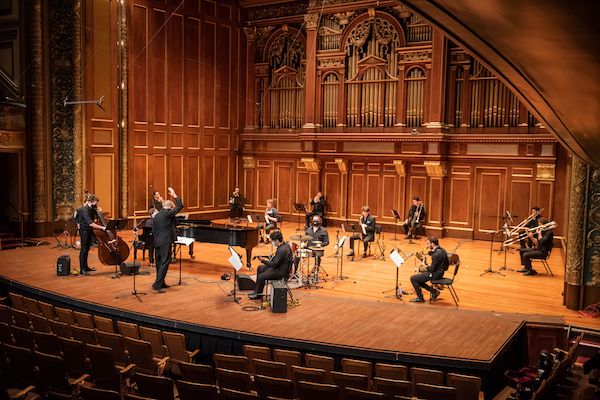Apr 2, 2024 12:59 PM
Saxophonist, Sonic Explorer Casey Benjamin Dies at 45
Casey Benjamin, the alto saxophonist, vocalist, keyboardist and producer who stamped his distinctive sounds on the…

NEC educator Ken Schaphorst conducts an ensemble of student musicians, several of whom are wearing face coverings.
(Photo: Andrew Hurlbut/NEC)As a recent issue of DownBeat went to press, the United States was facing frightening trends in terms of COVID-19 positivity rates. Many educational institutions were gleaning information from their fall 2020 experiences to help them prepare for multiple scenarios for spring and summer coursework, which might include fully remote learning, along with in-person classes held with strict safety protocols. At some schools, music students have followed a hybrid approach, wherein their performance-based classes were held in person, but their academic classes met online.
One such school is New England Conservatory in Boston, which welcomed students back to campus in the fall. NEC had about 700 students enrolled, with approximately 400 pursuing Boston-based instruction and another 300 taking classes remotely.
In mid-December and early January, DownBeat conducted Zoom interviews with NEC educators and an NEC student to get a sense of how the fall semester had transpired.
“Every class that could be [taught] fully online was held online,” said NEC President Andrea Kalyn, describing the school’s approach. “We really kept the performance-based work in person, as much as we could, although with social distancing, masks and [other protocols].”
Ken Schaphorst, chair of the jazz studies department, taught three classes in person. Students in his classes often were positioned farther than six feet apart, and the musicians always wore masks. Wind instrument students would remove their masks only when it came time to play.
Schaphorst and his students learned to adapt. “With a big band, where we need to be spread out in a large room, we’ve had to listen in a very different way,” he said. “We’ve learned to listen better. I’ve learned that if you look at someone, you actually hear them better. If I’m looking across the room at the trumpets, I mean, they might be 30 feet away.”
NEC presented numerous student concerts during the semester. These performances were either livestreamed or prerecorded, but in both situations, there was no in-person audience.
Delfina Cheb—a vocalist who graduated from Berklee College of Music and now is pursuing a master’s degree in NEC’s Contemporary Improvisation program—frequently was tested for COVID-19 during the fall. Cheb remained healthy throughout the semester, and she took pride in the level of musicianship that she and her peers were able to achieve.
“Everything that we presented just felt so well-rehearsed and so focused,” Cheb said. “When we were there [together] in the room, we all really wanted to be there. I really think that educationally, it’s been one of the best experiences I’ve had so far in my life.”
In terms of remote instruction, NEC educators described a contrast when comparing their experiences in the early days of the pandemic to what they were doing in late 2020.
David Zoffer—jazz department chair of NEC’s Preparatory and Continuing Education Program—has become an expert in assembling musicians remotely for real-time performances. He spent much of last year mastering the nuances of SoundJack, free software that, when combined with other new technology and relatively inexpensive hardware, allows for low-latency, synchronous music making. Zoffer has reached the point where he and his students essentially can play in sync without the lag that has become so frustratingly familiar to musicians during the pandemic. NEC has set up Low Latency Rooms on campus to help students take advantage of the technology.
“Once you get it working, it’s miraculous,” Zoffer said. “I think this is going to change rehearsals forever. ... Anybody within a 500-mile range can do this with each other.”
Kalyn believes that pragmatic hurdles can enhance a person’s appreciation for music: “At the beginning of [the pandemic], we stopped to think, ‘OK, what is the place of music in a world stricken by something so deadly, something so all-encompassing?’ What became very clear, very quickly, was that music is ... so elemental to our humanity. To watch everybody apply incredible human ingenuity to come together—digitally, and in person, with these restrictions—is very affirming.” DB

Benjamin possessed a fluid, round sound on the alto saxophone, and he was often most recognizable by the layers of electronic effects that he put onto the instrument.
Apr 2, 2024 12:59 PM
Casey Benjamin, the alto saxophonist, vocalist, keyboardist and producer who stamped his distinctive sounds on the…

“He’s constructing intelligent musical sentences that connect seamlessly, which is the most important part of linear playing,” Charles McPherson said of alto saxophonist Sonny Red.
Feb 27, 2024 1:40 PM
“I might not have felt this way 30 to 40 years ago, but I’ve reached a point where I can hear value in what people…

Albert “Tootie” Heath (1935–2024) followed in the tradition of drummer Kenny Clarke, his idol.
Apr 5, 2024 10:28 AM
Albert “Tootie” Heath, a drummer of impeccable taste and time who was the youngest of three jazz-legend brothers…

“Both of us are quite grounded in the craft, the tradition and the harmonic sense,” Rosenwinkel said of his experience playing with Allen. “Yet I felt we shared something mystical as well.”
Mar 12, 2024 11:42 AM
“There are a few musicians you hear where, as somebody once said, the molecules in the room change. Geri was one of…

Henry Threadgill performs with Zooid at Big Ears in Knoxville, Tennessee.
Apr 9, 2024 11:30 AM
Big Ears, the annual four-day music celebration that first took place in 2009 in Knoxville, Tennessee, could well be…